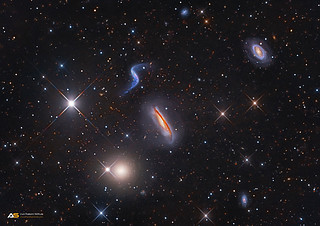Counting Galaxies in Hickson Compact Group 44 (Arp 316) – Interacting Galaxies
Arp 316 is in the Galaxy Groups class. This group, including NGC 3185, is also known as Hickson 44. Hickson 44 (Arp 316), galaxy group in constellation of the Lion ( Leo), with NGC 3185 (Sba), NGC 3187 (SBc/P), NGC 3190 (Sa), and NGC 3193 (E2).
Near J2000 RA 10 18 00, Dec +21 48 44; for more information click on the galaxy names:
Scanning the skies for galaxies, Canadian astronomer Paul Hickson and colleagues identified some 100 compact groups of galaxies, now appropriately called Hickson Compact Groups. The four prominent galaxies seen in this intriguing image are one such group, Hickson 44, about 100 million light-years distant toward the constellation Leo. The two spiral galaxies in the center of the image are edge-on NGC 3190 with its distinctive, warped dust lanes, and S-shaped NGC 3187. Along with the bright elliptical, NGC 3193 at the bottom left, they are also known as Arp 316. The spiral in the upper right corner is NGC 3185, the 4th member of the Hickson group. Like other galaxies in Hickson groups, these show signs of distortion and enhanced star formation, evidence of a gravitational tug of war that will eventually result in galaxy mergers on a cosmic timescale. The merger process is now understood to be a normal part of the evolution of galaxies, including our own Milky Way. For scale, NGC 3190 is about 75,000 light-years across at the estimated distance of Hickson 44.
Current theory is that compact groups represent physically related galaxies that are in the process of merging into a single object, most likely an elliptical galaxy. Compact groups are relatively short-lived entities that form via mergers of galaxies within loose subsystems and groupings. Simulations predict that merging of the group members should proceed rapidly within one billion years to form an elliptical galaxy. Hickson groups are therefore snapshots at various stages in this merging process. The more evolved groups are smaller and more deficient in neutral hydrogen while the least evolved resemble galaxies in looser groups. Observational evidence shows that interaction is occurring in a large fraction of galaxies in HCG supporting this model for the origin and evolution of HCG. The cosmological implications of compact groups are significant. Astronomers believe they may represent an intermediate stage between loose groups and individual galaxies. A better understanding of the nature of HCG could help explain galaxy formation on a larger scale in the early universe.
There are many more galaxies in the field. Close inspection of the frame and you will see the background also reveal a multitude of small galaxies, the small dots are not stars, but extremely galaxies located hundreds of millions of light years away.
Equipment
Location: Àger-Lleida-Catalonia-Spain
Average SQM: 21.6
Dates: Several months Jan-Feb-March -2018
Telescope: RC400 CFF Truss f/8 df:3200 mm
Mount: DDM85
Camera: Moravian G3-11000
Field Corrector: 70 mm
Exposures: L: 10h RGB: 19 h
Software: CCDStack + Pixinsight + Photoshop CC 2018
This fits liberator image is not available for sale.
Credit:NASA & ESA
About the FITS Image
| Id: | lluis_romero_01 |
| Name: | Lluís Romero |
| Country: | Chile |
